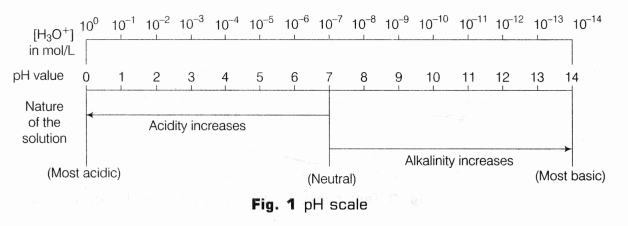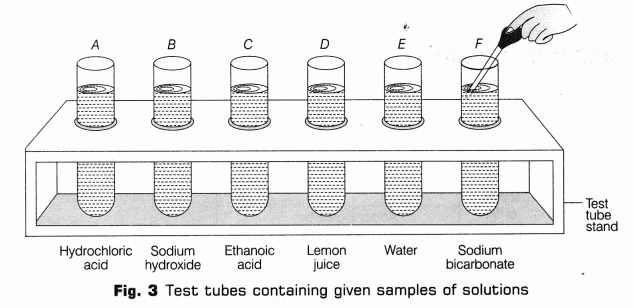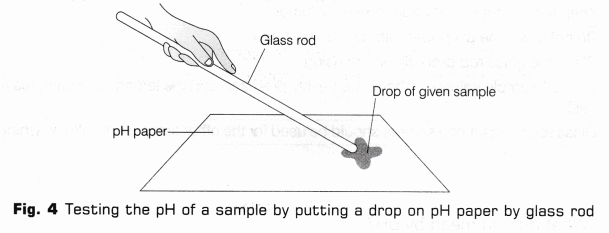CBSE Class 10 Science Lab Manual – pH of Samples
AIM
To find the pH of the following samples by using pH paper/universal indicator
- Dilute hydrochloric acid (HCl)
- Dilute sodium hydroxide (NaOH) solution ?
- Dilute ethanoic acid (CH3COOH) solution
- Lemon juice
- Water (H2O)
- Dilute sodium bicarbonate (NaHCO3) solution
MATERIALS REQUIRED
Six test tubes, test tube stand, glass rod, pH paper, dropper, standard pH colour chart, universal indicator, sample of solution—dilute HCl, dilute NaOH, dilute CH3COOH, dilute NaHCO3, water, lemon juice.
THEORY
The pH Scale
It is a scale used for measuring hydrogen ion concentration. The p in the pH stands for potenz which means power in German. It has values 0 (very acidic) to 14 (very alkaline). pH is a number which indicates the acidic or basic nature of a solution (as shown in Fig. 1).
Higher the hydronium ion concentration present in the solution, lower is its pH value. [pH means power of hydrogen ions]
- If pH > 7, solution is basic.
- If pH < 7, solution is acidic.
- If pH = 7, solution is neutral.

Pure water is neutral because of the absence of free ions. A paper impregnated with the universal indicator is used for measuring pH. Now-a-days, pH meter, an electronic device, is used to measure the pH. pH is defined as the negative logarithm of hydrogen ion concentration in moles per litre. The pH value has no unit. It can be written as:
pH = -log[H+] or pH = – log [H3O+]
pH Paper
pH of a solution can be determined by using pH paper. When the pH paper is dipped in the solution whose pH is to be found out, a colour is developed on the pH paper. The colour is matched with the standard colour chart (as shown in Fig. 2).

In the place of pH paper, we can use universal indicator solution or universal indicator paper to measure the pH. When we take a drop of the test solution and place it on universal indicator paper, the paper turns a particular colour. The colour of the indicator paper is then matched against a colour chart showing the pH value for different colours. Universal indicator is also available in the form of solution.
The colours produced by universal indicator at different pH values are given in table below.
| pH | Colour | pH | Colour | pH | Colour |
| 0 | Dark red | 5 | Orange-yellow | 10 | Dark blue |
| 1 | Red | 6 | Green-yellow | 11 | Purple |
| 2 | Light red | 7 | Green | 12 | Dark purple |
| 3 | Orange-red | 8 | Green-blue | 13 | Light violet |
| 4 | Orange | 9 | Blue | 14 | Violet |
Note: Violet/blue colour indicates alkaline solution, red/pink colour indicates acidic solution and green colour indicates neutral solution.
PROCEDURE
- Take each sample solution in a separate test tube and label them as A, B, C, D, E and F. Put all the test tubes one by one in a test tube stand (as shown in Fig. 3).

- Take a strip of pH paper and place it on cleaned and dry white surface.
- Dip glass rod into the sample solution of test tube A (dilute HCl).
- Put one or two drops of hydrochloric acid on the pH paper using clean glass rod as shown in the Fig. 4 given below.

- Observe the colour produced on pH paper and compare it with the different colour shades given in the standard pH colour chart.
- Note down the colour produced on pH paper and pH value in the observation table.
- Clean the glass rod properly, before taking another sample solution.
- Repeat the procedure from step (2) to (6) with acetic acid solution, lemon juice, water and dil. NaHCO3 separately.
- Observe the colour change in each sample and record pH in observation table.
- Decide nature of solutions of each sampie, i.e. acidic, basic or neutral with the help of respective pH value.
OBSERVATION AND INFERENCE
| S.No. | Sample solution | Observation (Colour produced on pH paper) | Inference (Approximate pH) |
| 1. | Dilute HCI | ||
| 2. | Dilute NaOH | ||
| 3. | Dilute CH3COOH | ||
| 4. | Lemon juice | ||
| 5. | Water | ||
| 6. | Dilute NaHC03 |
RESULT/CONCLUSION
The pH of the given samples by using pH paper are as follows:
- pH of dilute HCl is ……………. and nature of solution is …………
- pH of dilute NaOH is ………….. and nature of solution is ………….
- pH of dilute CH3COOH is …………….. and nature of solution is …………..
- pH of lemon juice is ………………. and nature of lemon juice is ……………
- pH of water is …………….. and it is ……………..
- pH of NaHCO3 is …………….. and nature of its solution is ………………..
PRECAUTIONS
- Use the dilute solution of all samples and label the test tube carefully.
- Do not touch, smell or taste any of the solution directly.
- Colour developed on the pH paper should be compared carefully with that of the chart.
- Keep the pH strips away from chemical fumes.
- Do not touch the pH paper with dirty or wet hand.
- Clean the glass rod properly before using.
- The test sample solutions should be freshly prepared and the lemon juice samples should also be fresh.
- Glass rod used for one sample should be used for the other sample only after washing it with water.
Viva – Voce
Question 1.
What do you mean by pH? [NCERT]
Answer:
The pH is the measure of the acidic (or basic) power of a solution. It is a scale for measuring hydrogen ion concentration in a solution. Higher the hydronium ion concentration in the solution, lower is their pH values.
Question 2.
What is the pH of pure water at 25°C (298 K)? [NCERT]
Answer:
The pH of pure water at 25°C is equal to 7.
Question 3.
What according to you should be the pH of dil. HCI and dil. NaOH solution? Observe and explain your findings. [NCERT]
Answer:
pH of dilute HCI is found to be 2 and pH of dilute NaOH is 14. Solutions with pH = 0 to 3 are strongly acidic, so dilute HCI is a strong acid. And the solution with pH = 12 to 14 are strongly basic, so dilute NaOH solution is a strong base.
Question 4.
On opening the soda water bottle the dissolved CO2 comes out, would the pH of the solution increase or decrease as the gas comes out ? Explain your answer. [NCERT]
Answer:
The pH of the solution will increase as the gas comes out and the solution becomes less acidic.
Question 5.
How is the concentration of hydronium ions (H3O+) affected, when a solution of an acid is diluted?
Answer:
On dilution of an acid, the concentration of hydronium ions (H3O+) per unit volume decreases.
Question 6.
Solid sodium bicarbonate was placed on a strip of pH paper. What colour would you observe on a strip of pH paper?
Answer:
The colour on a strip of pH paper would not change. (Since, an acid or base shows their nature in aqueous state only and not in solid or pure state, hence solid sodium bicarbonate does not affect the colour of pH paper).
Question 7.
What effect does the concentration of H+ (aq) have on the acidic nature of the solution?
Answer:
Higher the concentration of H+ ions in a solution, more acidic is the solution.
Question 8.
A student was given four unknown colourless samples labelled A, B, C and D and asked to test their pH using pH paper. He observed that the colour of pH paper turned to light green, dark red, light orange and dark blue with samples A, B, C and D respectively. Which sample is most acidic?
Answer:
Sample B
Question 9.
A student observed that the colour of pH paper changes to green when she dipped it in water. She added a few drops of concentrated hydrochloric acid to the water. What change in colour she would observe on pH paper?
Answer:
The colour of pH paper would turn to light red.
(Reason: The colour of pH paper is green in neutral medium while it is red in acidic medium).
Question 10.
Four students A, B, C and D measured the pH values of water, lemon juice and sodium bicarbonate solution. What is the correct decreasing order of the pH values?
Answer:
The correct decreasing order of pH values is lemon juice < water < sodium bicarbonate.
Question 11.
A student test a sample of drinking water and reports its pH as 6 at room temperature, which kind of compound do you think may have been added to water?
Answer:
Acidic compound like bleaching powder.
Bleaching powder in water liberates chlorine which makes its pH 6 (i.e. the solution becomes acidic).
Question 12.
Which will be more acidic and why?
(i) A solution with pH value of 6.0
(ii) A solution with pH value of 5.0
Answer:
[H+] in solution with pH 5.0 = 10-5 M
[H+] in solution with pH 6.0 = 10-6 M
As 10-5 > 10-6 hence, solution with pH 5 is more acidic.
Question 13.
Choose strong acid and strong base from the following: CH3COOH, NH4OH, KOH, HCI
Answer:
Strong acid—HCI, Strong base—KOH
Question 14.
Two solutions A and B were found to have pH value of 6 and 8 respectively. What inference can be drawn from this?
Answer:
pH value is 6, it means solution A is an acid. pH value is 8, it means solution B is base.
Question 15.
During an experiment a student accidently spilled hydrochloric acid on his hand. His teacher applied dilute solution of another chemical substance which relieved him from the burning sensation. What could possibly that dilute solution?
Answer:
The applied solution could be a basic solution like Mg(OH)2. It reacts with acid to form neutral salt.
Question 16.
Reena place one drop of each of hydrochloric acid, sodium hydroxide and lemon juice on a strip of red litmus paper one by one, in which case would you observe change of colour of litmus paper?
Answer:
(NaOH) sodium hydroxide.
Science Lab ManualScience Practical SkillsScience LabsMath LabsMath Labs with Activity
